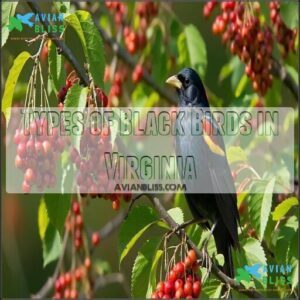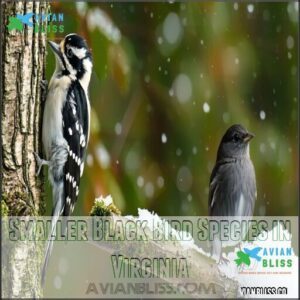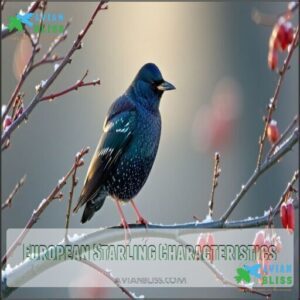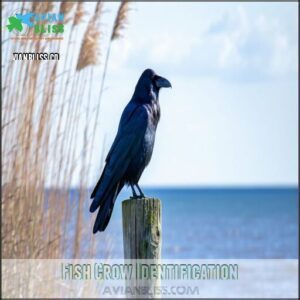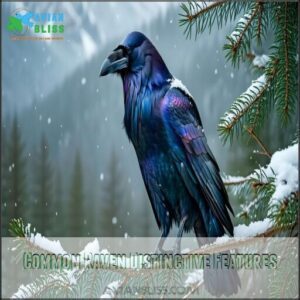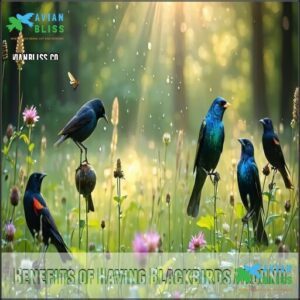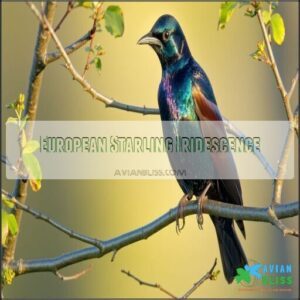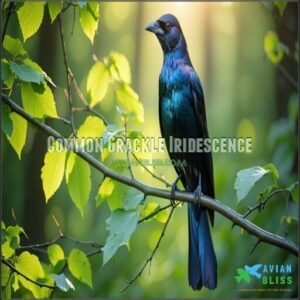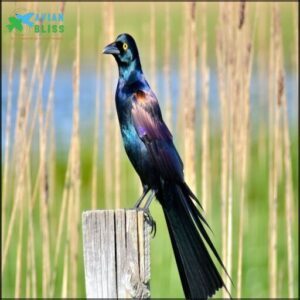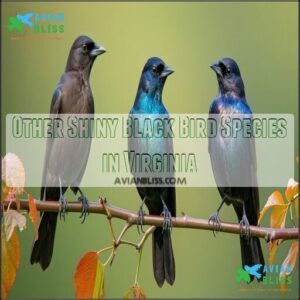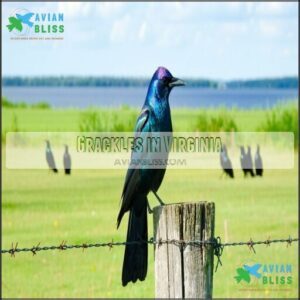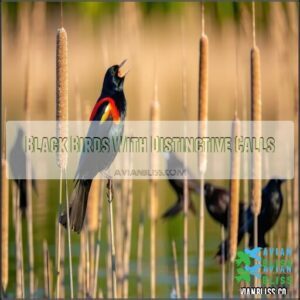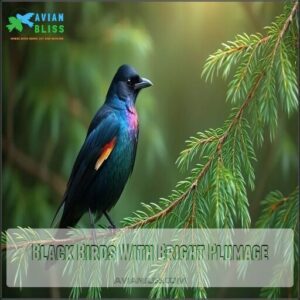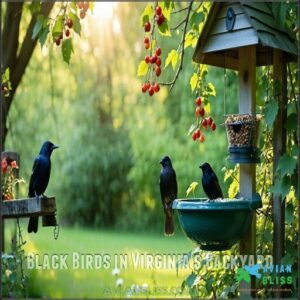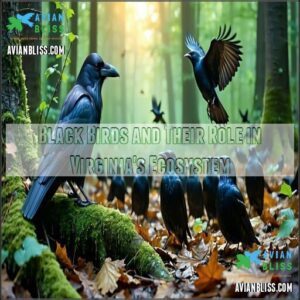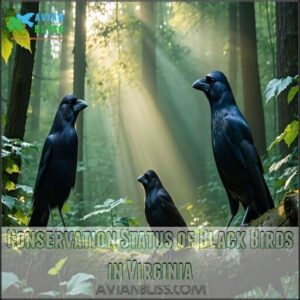This site is supported by our readers. We may earn a commission, at no cost to you, if you purchase through links.
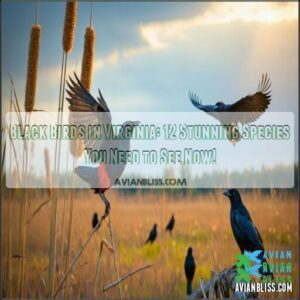
You’ll spot red-winged blackbirds flaunting their fiery shoulder patches near marshes, while common grackles shimmer with iridescent feathers in open fields.
Rusty blackbirds, often seen in wetlands, change plumage with the seasons.
Boat-tailed grackles prefer coastal areas, their calls loud and unmistakable.
Don’t confuse the fish crow with a raven—they’re smaller but equally clever.
European starlings, though invasive, dazzle with shiny, speckled feathers.
These birds aren’t just pretty; they play essential roles in seed dispersal and pest control.
Curious about their calls or habitats? Stay tuned!
Table Of Contents
- Key Takeaways
- Types of Black Birds in Virginia
- Black Birds That Look Like Crows
- Benefits of Having Blackbirds Around
- Shiny Black Birds in Virginia
- Grackles in Virginia
- Black Birds With Distinctive Calls
- Black Birds With Bright Plumage
- Black Birds in Virginia’s Backyard
- Black Birds and Their Role in Virginia’s Ecosystem
- Conservation Status of Black Birds in Virginia
- Frequently Asked Questions (FAQs)
- Are there Blackbirds in Virginia?
- What birds live in Virginia?
- What kind of Blackbird flies over Virginia?
- What do blackbirds look like in Virginia?
- Is there a more beautiful black bird in Virginia?
- Are there brown birds in Virginia?
- Are there blackbirds in Virginia?
- Are blackbirds good to have around?
- What is a small black bird that looks like a crow?
- What are these black birds in my yard?
- Conclusion
Key Takeaways
- You’ll find 16 species of blackbirds in Virginia, like Red-winged Blackbirds with their red shoulder patches and Common Grackles with glossy, iridescent feathers.
- Blackbirds play key roles in seed dispersal, pest control, and ecosystem health, making them vital to Virginia’s environment.
- Habitats for blackbirds range from wetlands and forests to urban areas, with some species migrating seasonally while others stay year-round.
- You can attract blackbirds to your yard with native plants, bird feeders offering seeds or fruit, and clean water sources like bird baths.
Types of Black Birds in Virginia
Virginia hosts 16 species of blackbirds from the Icteridae family including Red-winged Blackbirds with their distinctive shoulder patches.
Brown-headed Cowbirds are known for laying eggs in other birds’ nests.
You’ll find these adaptable birds in various habitats from wetlands and forests to urban areas where they feed on insects, seeds and fruits.
Common Blackbirds of The Chesapeake Watershed
Exploring the Chesapeake watershed reveals an impressive variety of blackbirds that call this diverse ecosystem home.
You’ll find these species thriving across Virginia’s wetlands, forests, and even urban areas, each playing a vital role in maintaining ecological balance.
The watershed supports several common blackbird species:
- Red-winged Blackbirds dominate marshy areas with males displaying vibrant shoulder patches
- Common Grackles frequent open woodlands and suburban areas with their iridescent blue-black plumage
- Brown-headed Cowbirds adapt well to agricultural fields and pastures throughout the region
These watershed blackbirds consume varied diets ranging from insects to seeds, helping control pest populations.
Their migration patterns differ, with some species remaining year-round while others travel seasonally.
Virginia bird identification becomes easier when you observe habitat preferences and behavior.
Conservation challenges affect certain species like the Rusty Blackbird, which has experienced significant population decline due to habitat loss within the Chesapeake watershed.
Red-Winged Blackbird Characteristics
Moving from the diverse blackbirds of the Chesapeake, let’s focus on the Red-winged Blackbird (Agelaius phoeniceus), one of Virginia’s most recognizable black bird species.
Male plumage features glossy black feathers with bright red shoulder patches bordered by yellow. Female markings contrast sharply with brown streaked bodies and subtle yellow hints near the bill, providing excellent camouflage in marsh vegetation.
The Redwinged Blackbird’s territoriality is legendary among black birds in Virginia. Males defend their space vigorously with distinctive vocalizations – a loud "conk-la-ree" call that carries across wetlands.
- Males flash shoulder patches during displays to attract females
- Females build cup-shaped nests in cattails and marsh plants
- These blackbirds form large flocks in winter after breeding season
Bird identification becomes simple once you spot those unmistakable red epaulets.
Rusty Blackbird Identification
Identifying the Rusty Blackbird in Virginia requires attention to key features.
In winter plumage, males display rusty feather edges with pale yellow eyes, while females show straw-colored buff with rusty-edged feathers.
Listen for their distinctive "squiggle" calls when mixed with other black bird species.
Look for them in wooded swamps and marshes, often traveling in small flocks.
Unlike similar species, Rusty Blackbirds have bright yellow eyes, thinner bills than Common Grackles, and less glossy plumage than Brewer’s Blackbird.
Common Grackle Distinctive Features
While Rusty Blackbirds showcase subtle winter coloration, Common Grackles stand out in Virginia’s landscape with unmistakable features.
You’ll immediately notice their iridescent plumage that shifts between purple, blue, and bronze depending on the sunlight angle. Their keel-shaped tail extends dramatically during flight, making identification easier from a distance.
Common Grackles (Quiscalus quiscula) from the Icteridae family boast several distinctive features:
- Piercing yellow eyes that contrast sharply with their dark faces
- Long, sturdy black bills perfect for their adaptable diet of seeds and insects
- Males display more vibrant iridescence than females
- Larger size (12-13 inches) than most backyard black birds in Virginia
Their harsh "readle-eak" grackle vocalizations often announce their presence before you spot them, especially during communal nesting season when dozens gather in single trees.
Boat-Tailed Grackle Habitat and Behavior
While Common Grackles populate most of Virginia, the Boat-tailed Grackle stakes its claim along Virginia’s coastal regions.
You’ll find these striking black birds exclusively within 30 miles of saltwater, particularly in salt and freshwater marshes along the Atlantic coast.
Males display glossy blue-black plumage with unusually long tails, while females are rich dark-brown and distinctly smaller.
Their foraging strategies are fascinating to observe—they walk on long legs with tails cocked upward, searching mudflats, beaches, and even parking lots for food.
In coastal habitats, they stand motionless, watching water with one eye before plunging below the surface for aquatic insects, crabs, or small fish.
Their large, bulky nests in marsh vegetation are built and maintained entirely by females, showcasing a unique aspect of their social behavior.
Black Birds That Look Like Crows
You’ll find several black bird species in Virginia that look similar to crows but have distinct features like the European Starling’s iridescent plumage and the Fish Crow’s unique call.
These look-alike species can be identified by their size, behavior and habitat preferences with the Common Raven being larger than the American Crow and smaller species showing distinctive markings.
Smaller Black Bird Species in Virginia
While Virginia hosts many large black birds, several smaller species often catch birdwatchers’ attention. These compact birds may resemble crows but show distinct characteristics upon closer inspection.
- Downy Woodpeckers display black-and-white plumage with males sporting red head patches, typically measuring just 6-7 inches long.
- Dark-eyed Juncos exhibit slate-gray upperparts with white bellies, commonly seen at winter feeders across Virginia.
- Brown-headed Cowbirds feature glossy black bodies with brown heads in males, with cowbird size averaging 7-8 inches – particularly smaller than crows.
The Eastern Towhee behavior of backward hopping while foraging makes this small black bird instantly recognizable in Virginia’s woodlands.
Many species use striking coloration as effective camouflage. Starling size averages 8-9 inches, providing another helpful identification marker.
European Starling Characteristics
European Starlings stand out among black birds in Virginia with their purple-green iridescent plumage that changes seasonally.
This invasive species shows remarkable urban adaptation and aggressive behavior at feeders.
You’ll recognize them by:
- Stocky 8-inch body with triangular wings
- Yellow bill in summer, black in winter
- Pink legs and feet that contrast with dark feathers
- Exceptional vocal mimicry skills, imitating other birds and sounds
Fish Crow Identification
How can you tell a Fish Crow from an American Crow in Virginia? Listen for their distinctive nasal call that sounds like "uh-uh" rather than the familiar "caw."
These black birds feature:
- Smaller size (15-18 inches) with more compact bodies
- Glossy black plumage with subtle blue-purple sheen
- Thinner, more pointed bill than American Crows
Fish Crows prefer coastal areas and rivers throughout Virginia. Their social behavior includes forming small flocks that patrol shorelines for food.
Juvenile plumage appears duller than adults. When habitats overlap with American Crows, flight patterns provide another clue—Fish Crows typically fly with quicker wingbeats.
Common Raven Distinctive Features
While the Fish Crow has its own charm, nothing compares to the majestic Common Raven you’ll spot in Virginia’s mountains and forests.
Unlike other black birds in Virginia, ravens showcase remarkable intelligence – they can solve puzzles and even mimic human speech. Their massive size (twice a crow’s!) makes identification easier, with distinctive wedge-shaped tails and shaggy throat feathers called "hackles."
Ravens display glossy black plumage with purple-blue iridescence in sunlight. Their deep, resonant "cronk" vocalizations differ dramatically from a crow’s cawing.
These adaptable birds have survived for centuries through remarkable problem-solving abilities. They’re known to use tools and work cooperatively – truly the intellectuals of Virginia’s bird species.
Benefits of Having Blackbirds Around
You’ll find that blackbirds help maintain ecological balance by consuming large quantities of insects and dispersing seeds across Virginia’s diverse habitats.
These adaptable birds also serve as important environmental indicators, with their population trends reflecting the health of local ecosystems.
Ecological Role of Blackbirds in Virginia
Unlike their crow cousins, blackbirds in Virginia serve as essential ecosystem engineers across the state’s diverse habitats.
These birds control insect populations by consuming large quantities of pest species that could damage crops and natural vegetation. They also play a key role in seed dispersal, carrying plant seeds to new areas as they travel between feeding grounds.
- When blackbirds forage in wetlands, they help maintain wetland health by aerating soil and controlling aquatic insect populations.
Their scavenging impacts help clean environments and recycle nutrients throughout Virginia’s avian ecology, which is crucial for maintaining a healthy environment, and they contribute to ecosystem health.
Blackbirds as Indicators of Environmental Health
Blackbirds in Virginia act as nature’s health monitors.
Research at Virginia Tech shows these birds can detect environmental problems before humans notice. Their habitat sensitivity makes them excellent indicators of ecosystem changes.
When blackbird populations decline, it signals ecosystem stress. Scientists track telomere length in blackbirds to measure pollution impacts and bioaccumulation effects.
These birds serve as sentinel species, revealing potential risks to humans.
The table below shows how blackbirds help monitor Virginia’s environmental health:
Blackbirds as a Food Source for Other Animals
Many predators rely on Virginia’s blackbirds as a vital food source in the local ecosystem.
These birds contribute substantially to the region’s complex food web through:
- Nestling Vulnerability: Hawks, owls, and raccoons target unprotected eggs and young birds, particularly during breeding season.
- Predator Diets: Larger birds of prey develop specialized hunting techniques to capture adult blackbirds, supporting raptor populations.
- Scavenger Roles: When blackbirds die naturally, they provide nutrition for turkey vultures, beetles, and other decomposers.
This predation maintains natural population controls while supporting ecosystem health across Virginia’s diverse habitats.
Some species, like the Black Vulture, even have omnivorous feeding habits.
Without blackbirds, many predator species would face substantial diet gaps and potential population declines.
Blackbirds and Their Role in Seed Dispersal
Beyond serving as food, blackbirds contribute to Virginia’s landscape through seed dispersal.
When these birds consume fruits, they transport seeds to new areas through their droppings.
| Species | Dispersal Mechanism | Habitat Impact |
|---|---|---|
| Red-winged Blackbird | Fruit consumption | Wetland regeneration |
| Common Grackle | Berry transport | Forest expansion |
| Rusty Blackbird | Seed predation/dispersal | Swamp ecosystem dynamics |
This natural distribution helps plants colonize new territories, increasing biodiversity while maintaining ecosystem balance throughout Virginia’s varied environments, which is crucial for landscape regeneration.
Shiny Black Birds in Virginia
You’ll spot several shiny black birds in Virginia that catch sunlight with their iridescent feathers.
European Starlings, Common Grackles and Boat-tailed Grackles display glossy plumage with purple-green sheens that transform as they move.
European Starling Iridescence
Looking through binoculars at a European Starling reveals their remarkable iridescence. The plumage of these black birds in Virginia transforms with each movement as sunlight strikes specialized feather structures.
Their iridescence comes from microscopic layers that split light through reflection, creating:
- Shifting colors from purple to green depending on viewing angle
This natural phenomenon varies seasonally, with breeding adults showing the most intense coloration.
The European Starling’s iridescence isn’t just beautiful—it’s a useful bird identification feature.
Their shimmering black appearance distinguishes them from other species, with plumage coloration most vibrant when observed in direct sunlight from multiple angles.
Common Grackle Iridescence
While European Starlings showcase impressive iridescence, the Common Grackle takes this natural light show to another level. When sunlight hits a Common Grackle’s feathers, their seemingly plain black plumage transforms into a shifting display of blues, purples, and greens.
This iridescence isn’t from pigments but results from the feather structure itself. The magic happens through microscopic keratin platelets in their feathers that reflect light at different angles.
As the bird moves, these surfaces catch light differently, creating the color-changing effect you’ll notice most prominently around their neck and head regions.
- Unlike regular coloration, Grackle iridescence varies with viewing angle and lighting conditions, appearing most vibrant in direct sunlight.
This structural coloration serves a practical purpose beyond beauty – it helps with species recognition and plays a role in mate selection throughout Virginia.
Boat-Tailed Grackle Iridescence
Moving from the Common Grackle to its coastal relative, the Boat-tailed Grackle showcases some of Virginia’s most impressive black bird iridescence.
When sunlight hits their feathers, you’ll notice an almost magical color shift between deep blue-green and purple hues.
This visual effect comes from specialized feather structure that breaks light into components through reflection.
Male Boat-tailed Grackles use this iridescence during breeding displays, combining their glossy black plumage with bright yellow eyes and distinctive keel-shaped tails.
Their light reflection properties make these black birds appear to change color as they move through Virginia’s coastal habitats.
Other Shiny Black Bird Species in Virginia
Throughout spring, Virginia hosts several shiny black bird species beyond the familiar favorites.
When observing these iridescent birds, note:
- The Brown-headed Cowbird’s glossy black body contrasts with its chocolate-brown head
- The Rusty Blackbird displays subtle green-blue iridescence on its wings during breeding season
- The Brewer’s Blackbird, though rare in Virginia, exhibits a purple head sheen and green body
Plumage variation between males and females is significant, with juvenile appearance typically duller. Regional abundance varies, with conservation challenges affecting species like the Rusty Blackbird.
Grackles in Virginia
You’ll spot Common Grackles throughout Virginia with their iridescent purple heads and glossy black bodies that shine in the sunlight.
These year-round residents form noisy colonies in shorelines, fields and suburban areas where they forage for insects, seeds and sometimes even small fish.
Common Grackle Habitat and Behavior
Common Grackles thrive throughout Virginia in both urban and rural settings.
While nesting in tall trees, these birds forage on open grounds for insects, seeds, and small vertebrates.
| Habitat | Social Behavior |
|---|---|
| Urban parks | Form large, noisy flocks |
| Agricultural fields | Show communal nesting |
| Suburban areas | Display complex hierarchies |
You’ll notice their iridescent black feathers as they adapt to changing environments.
Common Grackles demonstrate remarkable urban adaptation by using artificial structures for nesting.
Their foraging strategies include following plows in fields and visiting backyard feeders.
During breeding season, they become territorial, with males actively defending nest sites.
Grackle Migration Patterns
Thousands of grackles travel Virginia’s skies twice yearly as their migration patterns unfold between February-March and October-November.
These black birds respond to migration triggers like weather changes and food availability, creating stunning aerial rivers that can contain up to one million birds.
5 Key Migration Facts:
- Common Grackles travel short distances, typically 200-600 miles from breeding grounds
- Winter roosts form massive communal gatherings that disperse by mid-February
- Northern Virginia grackles head south while some southern populations remain year-round
- Breeding dispersal begins in March when winter flocks split up to establish nesting territories
- Climate impacts are changing traditional migration timing and routes
You’ll spot these birds gathering on powerlines before departure or forming "black carpets" in the sky.
Their stopover ecology includes resting in wetlands, fields, and even suburban areas where they seek food resources. They rely on visual landmarks during their travels.
Grackle Diet and Foraging Habits
Grackles are nature’s resourceful foragers, adapting their bird diet to what’s available.
You’ll see them in fields, backyards, and wetlands, exploiting every opportunity. They love seeds, insects, and even human leftovers.
Their dietary adaptations make them skilled at urban foraging and thriving in varied bird habitats. Seasonal variations in food preferences also highlight their flexibility, though their habits often label them as agricultural pests.
| Foraging Locations | Seasonal Variations | Food Preferences |
|---|---|---|
| Urban areas | Summer: Insects | Seeds, grains, insects |
| Wetlands | Fall: Seeds | Crustaceans, small fish |
| Agricultural fields | Winter: Leftovers | Human scraps, discarded food |
Black Birds With Distinctive Calls
You’ll recognize many black birds in Virginia by their unique calls that stand out in various habitats.
From the melodic whistles of the Red-winged Blackbird to the sharp, metallic notes of the European Starling, each species has a sound that’s easy to identify.
European Starling Calls
European Starlings are vocal powerhouses among black birds in Virginia, showcasing remarkable mimicry abilities.
Their bird sounds go beyond typical calls, creating a symphony of Starling Vocalizations.
- Mimicry Abilities: They replicate sounds from meadowlarks, jays, and even car alarms with uncanny accuracy.
- Call Development: Each starling crafts unique vocal patterns, blending whistles, clicks, and trills.
- Regional Dialects: Starlings develop distinct calls influenced by their surroundings.
- Call Meanings: These bird vocalizations signal territory, attract mates, or warn of predators.
In Virginia, their ever-changing repertoire makes European Starlings a fascinating part of the local soundscape.
These calls are essential for territory and mating.
Common Grackle Calls
Ever noticed the Common Grackle’s vocalizations filling the air? These black birds of Virginia are masters of sound, showcasing call variations that range from sharp "screee" alarms to social "gronk-gronk" chatter.
Their mimicry abilities shine during breeding season, with males imitating creaks, squeals, and even rusty hinges. Grackles use these bird sounds strategically—warning of predators, attracting mates, or marking territory.
Notably, regional dialects add a unique twist, as grackle calls differ slightly across areas. These bird vocalizations reveal a complex social world, proving the Common Grackle is more than just a noisy neighbor; it’s a skilled communicator of nature, with mimicry abilities that include imitating sharp "screee" alarms and social "gronk-gronk" chatter.
Red-Winged Blackbird Calls
The Red-winged Blackbird’s call is one of the most recognizable bird sounds in Virginia.
Their bold "konk-la-ree" resonates across wetlands, serving multiple purposes. Males use these territorial songs to defend their space and attract mates, while females respond with shorter, sharper vocalizations like "check" or "teer."
During the breeding season, their vocalizations intensify, with song dialects varying slightly by region. Alarm calls alert the flock to predators, showcasing their survival instincts.
Each sound plays a role in their complex communication system, making them fascinating songbirds to observe.
- **Did you know?
** Male Red-winged Blackbirds can sing up to 200 different songs, each suited for specific situations!
Other Black Bird Species With Distinctive Calls
Beyond the Red-winged Blackbird’s calls, black birds in Virginia add rich layers to the soundscape.
The Brown-headed Cowbird’s bubbling notes surprise with their intricacy. Bobolinks charm with their rolling song, while Brewer’s Blackbirds produce a sharp gurgle.
Juncos trill softly in the background, blending into woodland settings. The Common Grackle’s rusty-hinge sound stands out, and the Boat-tailed Grackle adds depth with its harsh cries.
Rusty Blackbirds contribute a softer, seasonal chatter. Each bird’s call, from the Towhee’s “tow-hee” to the American Crow’s caws, creates a symphony of unique bird sounds across Virginia.
Black Birds With Bright Plumage
Some black birds in Virginia feature striking plumage that goes beyond their dark feathers.
You’ll notice vibrant reds, yellows, and iridescent hues that make these species stand out in their habitats.
Red-Winged Blackbird Plumage
Male Red-winged Blackbirds in Virginia are a sight to behold. Their male plumage features jet-black feathers with striking red shoulder patches, edged in yellow, making them standout among New World Blackbirds.
Females, however, have streaky brown markings for camouflage. Here’s a quick breakdown of their plumage:
- Males: Glossy black with bold red and yellow accents.
- Females: Brown with streaks for blending into marshes.
- Juveniles: Mimic female markings for protection.
- Seasonal variation: Brighter colors during breeding.
- Purpose: Males attract mates, females prioritize survival.
These black birds enrich Virginia’s bird species diversity.
Common Grackle Plumage
The Common Grackle’s plumage is a spectacle of iridescent colors, making it one of the most striking black birds in Virginia.
Males display a glossy plumage that shifts between purple, blue, and green hues, resembling polished metal under sunlight. Their tails and wings often gleam with a bronze finish, adding to their visual appeal.
Females, however, feature muted tones, with brownish feathers that lack the males’ vibrant shine.
- Seasonal variation affects the intensity of their iridescent plumage.
- Juvenile plumage is duller, often brownish, and lacks metallic sheen.
- Plumage health depends on diet and environmental factors.
Boat-Tailed Grackle Plumage
Spot the Boat-tailed Grackle in Virginia’s marshes, where its plumage steals the show.
Males showcase dazzling iridescence with blue-black and purple hues, while females flaunt rich brown tones.
Juveniles lean toward muted shades.
| Trait | Male Iridescence | Female Plumage |
|---|---|---|
| Feather Texture | Glossy | Smooth |
| Tail Appearance | Long, fan-shaped | Sleek, proportional |
| Seasonal Changes | Distinct Molting Patterns | Minimal Variations |
These black birds in Virginia are a visual treat!
Other Black Bird Species With Bright Plumage
Virginia’s skies are alive with striking black birds showcasing dazzling plumage.
Here are five species you’ll love spotting:
- Baltimore Oriole – Its bold orange and black make it a standout among New World Blackbirds.
- Orchard Oriole – A rich rust and black pattern sets it apart.
- Yellow-headed Blackbird – Bright Meadowlark Yellow heads contrast against jet-black bodies.
- Rusty Blackbird – Subtle metallic tones shimmer in sunlight.
- Bobolink – Unique patterns with cream caps and white backs.
These bird species add vibrant life to Virginia!
Black Birds in Virginia’s Backyard
You can attract black birds to your backyard by providing food, water, and shelter that meet their needs.
Planting native trees and shrubs or setting up feeders with seeds and fruits can make your yard a welcoming habitat.
Attracting Black Birds to Your Yard
Creating a bird-friendly yard is simpler than you think.
Black birds backyard enthusiasts love using Backyard Bird Feeders stocked with sunflower seeds, cracked corn, or suet to attract species like grackles and starlings. Add water sources like shallow bird baths with smooth stones for easy access and hydration.
You can also attract more birds by using specialized feeder designs.
Watching birds splash in fresh water adds life to your yard, making it a buzz with activity.
Position feeders near shrubs or trees to provide safe nesting habitats and perching spots.
Regularly clean feeding stations to keep bird feeding hygienic.
With these bird attraction tips, your yard will be filled with life.
Black Bird-Friendly Plants and Trees
Transform your yard into a haven for black birds Virginia loves by planting Native Berry Bushes, Insect-Attracting Plants, and Seed-Bearing Trees.
These plants provide food, nesting habitat, and shelter for black birds backyard enthusiasts aim to attract.
Consider oak trees for caterpillars, berry shrubs for winter food, and native grasses for ground cover.
Flowering plants draw insects, while understory plants offer essential shelter.
You can find various native species suitable for your local environment.
With thoughtful choices, your black birds garden becomes a thriving ecosystem, supporting diverse species and creating an inviting space for birds to forage and nest.
Black Bird Feeders and Bird Baths
Drawing black birds to your yard requires thoughtful feeder types and bath maintenance.
Place feeders near shrubs or trees for safety and rotate locations to keep them curious. Bird baths should be shallow, around 2-3 inches deep, with clean water refreshed daily. Winter baths are essential for hydration during colder months.
Many enthusiasts find success using specialized feeding equipment.
- Feeder Types: Use tube feeders or metal cages to deter squirrels.
- Placement Tips: Position feeders in shaded, protected areas.
- Water Source: Make certain baths stay clean and accessible year-round for backyard birding success.
Creating a Black Bird-Friendly Habitat
A thriving black birds habitat starts with native plants like berry bushes for food and dense shrubs for nesting sites.
Add bird feeders and fresh water sources to attract black birds Virginia loves, like red-winged blackbirds.
Reduce pesticides to protect their diet, and try winter feeding to support seasonal visitors.
These simple steps guarantee your yard becomes a black bird sanctuary!
Black Birds and Their Role in Virginia’s Ecosystem
Black birds play key roles in Virginia’s ecosystem by dispersing seeds, pollinating plants, and controlling insect populations. Their presence also helps scientists monitor environmental health and biodiversity.
Black Birds as Seed Dispersers
Black birds in Virginia aren’t just visitors to your backyard—they’re nature’s gardeners.
Through their seed dispersal methods, these bird species shape ecosystems in surprising ways. Their diet includes fruits, and as they digest, seeds are spread across habitats through droppings. Sometimes, seeds hitch a ride on their feathers or get buried and forgotten.
This dietary influence helps regenerate forests, improve biodiversity, and expand plant life. By spreading seeds over long distances, black birds’ habitat impact benefits ecosystems far beyond their immediate surroundings.
- Tip: Offer fruit at bird feeders to attract seed-dispersing black birds.
Black Birds as Pollinators
Through nectar consumption and pollen transfer, black birds in Virginia quietly boost pollination efficiency.
Species like Red-winged Blackbirds and Common Grackles visit flowers, spreading pollen between plants in marshes and backyards.
Rusty Blackbirds prefer wetland blooms, showing diverse floral preferences.
Their behavior creates a ripple effect, supporting local ecosystems.
These bird species play a pivotal role, proving their ecosystem impact goes beyond seed dispersal to include pollination.
Black Birds as Indicators of Environmental Health
Think of blackbirds as nature’s early warning system, especially in Virginia suburbs.
Their behaviors and population trends reveal hidden ecosystem changes.
Here’s how they act as environmental health indicators:
- Habitat Sensitivity: Declining numbers point to habitat degradation.
- Pollution Indicators: Diet shifts hint at bioaccumulation effects from contaminants.
- Population Decline: Fewer blackbirds signal broader bird conservation challenges.
- Ecosystem Changes: Altered migration patterns reflect climate shifts.
- Bird Species Diversity: A healthy variety means stable ecosystems.
By monitoring these feathered sentinels, you can support bird habitat preservation and understand how environmental shifts affect wildlife.
Black Birds and Their Impact on Other Species
Picture Virginia’s ecosystem as a lively chessboard, where blackbirds make bold moves that ripple across bird communities.
Their behavior sparks ecosystem changes through:
- Brood parasitism: Brown-headed Cowbirds practice brood parasitism, laying eggs in other birds’ nests. This forces unsuspecting hosts to raise cowbird chicks, often at the expense of their own offspring.
- Competition: Common Grackles and European Starlings engage in fierce resource competition, depleting food supplies and nesting spots essential for native species.
- Predation effects: Blackbirds control insect populations, which helps some species thrive but disrupts others reliant on those insects.
These interactions show how blackbirds influence bird communities, reshape territories, and drive resource depletion, keeping nature’s balance in constant motion.
Conservation Status of Black Birds in Virginia
Black birds in Virginia face challenges from habitat loss, agricultural practices, and declining populations. Understanding their conservation status helps you recognize threats and support efforts to protect these unique species.
Threats to Black Bird Populations
Virginia’s black birds face mounting challenges threatening their survival.
Habitat loss from urban sprawl and agricultural practices shrinks critical bird habitats.
Climate change disrupts migration patterns and alters food availability, adding stress to bird population trends.
Pesticide use reduces insect prey, while invasive species outcompete native birds for resources.
Persecution, such as labeling birds as pests, further harms their numbers.
Protecting these species requires understanding these threats and prioritizing bird conservation efforts to safeguard their future, which is crucial for their survival.
Conservation Efforts for Black Birds
Protecting black birds in Virginia takes a multi-pronged approach.
Conservation efforts include:
- Habitat Restoration: Reviving wetlands and grasslands provides essential spaces for feeding and nesting.
- Population Monitoring: Tracking black bird numbers helps identify declining species and threats.
- Citizen Science: Encouraging residents in Virginia suburbs to join bird conservation efforts boosts data collection and awareness.
Reducing pesticides and enforcing legal protections also strengthen bird species conservation across Virginia’s diverse wildlife landscapes.
Black Bird Habitat Preservation
Preserving blackbird habitats means balancing Wetland Restoration, Grassland Protection, and Forest Conservation with Urban Habitats and Agricultural Impacts.
Small changes in Virginia suburbs—like planting native shrubs or protecting wetlands—boost black birds conservation. Here’s a quick guide:
| Habitat Type | Key Action | Benefits |
|---|---|---|
| Wetlands | Restore vegetation | Supports nesting |
| Grasslands | Limit mowing | Protects foraging |
| Forests | Plant native trees | Enhances shelter |
| Urban Habitats | Add bird feeders | Aids migration |
Research and Monitoring of Black Bird Populations
Tracking black birds in Virginia involves a mix of science and community effort.
Researchers use these five methods to study population trends and conservation impacts:
- Population Surveys: Monitor bird populations to identify changes.
- Nest Monitoring: Assess breeding success and habitat use.
- Citizen Science Projects: Engage locals in bird monitoring.
- Banding Studies: Understand migration patterns through marked birds.
- Tracking Technologies: GPS and acoustic tools reveal movements.
Together, these strategies support bird research and habitat monitoring for black birds in Virginia.
Frequently Asked Questions (FAQs)
Are there Blackbirds in Virginia?
Yes, Virginia hosts 16 species of New World Blackbirds, including Orioles, Meadowlarks, and Grackles.
They’re colorful members of the Icteridae family, thriving in wetlands, grasslands, and urban areas.
Many migrate seasonally across the state.
What birds live in Virginia?
You might think Virginia’s birdlife is limited, but over 400 species thrive here.
From wetlands to backyards, you’ll find vibrant warblers, majestic hawks, playful woodpeckers, and common crows, each adding charm to the landscape.
What kind of Blackbird flies over Virginia?
You’ll find various blackbirds in Virginia, like Red-winged Blackbirds, Common Grackles, and Rusty Blackbirds.
They thrive in wetlands, grasslands, and urban areas, with striking plumage and behaviors like brood parasitism or territorial displays.
What do blackbirds look like in Virginia?
Did you know male blackbirds can be up to 60% heavier than females?
In Virginia, they often showcase glossy black, iridescent plumage, with some species displaying vivid red, yellow, or brown markings for contrast.
Is there a more beautiful black bird in Virginia?
The Red-winged Blackbird stands out with its striking red and yellow shoulder patches, but beauty is subjective.
If iridescence catches your eye, the Common Grackle’s shimmering purple and green feathers might win your vote.
Are there brown birds in Virginia?
Virginia’s skies host many brown birds, like the female Brown-headed Cowbird and Eastern Towhee.
These birds often blend into their surroundings, but their subtle tones and unique behaviors make them just as fascinating as brighter species, with their presence being a notable aspect of the brown birds.
Are there blackbirds in Virginia?
Yes, Virginia has blackbirds, including Red-winged Blackbirds, Common Grackles, and Brown-headed Cowbirds.
They thrive in wetlands, grasslands, and urban areas, showcasing diverse behaviors like brood parasitism and striking plumage patterns across species.
Are blackbirds good to have around?
Blackbirds can be beneficial, controlling pests by eating insects and seeds.
However, some species, like cowbirds, disrupt ecosystems by laying eggs in other birds’ nests.
Their impact depends on the species and your environment.
What is a small black bird that looks like a crow?
A small black bird resembling a crow could be a Common Grackle or a European Starling.
Both have glossy black feathers, but grackles show iridescence, while starlings often display speckled patterns and yellow beaks.
What are these black birds in my yard?
Not all black birds are crows.
In your yard, you might spot Red-winged Blackbirds with red-yellow shoulders, Common Grackles with iridescent feathers, or Brown-headed Cowbirds, known for laying eggs in others’ nests.
Conclusion
Imagine flipping through nature’s playlist, and black birds in Virginia provide the soundtrack.
These fascinating species, from the shimmering common grackle to the clever fish crow, enrich ecosystems with their roles in seed dispersal and pest control.
By understanding their habitats and behaviors, you can better appreciate their importance. Whether they’re brightening wetlands or visiting your backyard, these birds are more than just striking; they’re essential.
Explore, observe, and protect these remarkable avian neighbors.
- https://en.wikipedia.org/wiki/Eugene_Schieffelin
- https://www.bbc.com/future/article/20191211-crows-could-be-the-smartest-animal-other-than-primates
- https://www.audubon.org/magazine/10-fun-facts-about-red-winged-blackbird
- https://www.nationalgeographic.com/animals/birds/facts/european-starling
- https://www.allaboutbirds.org/guide/Brown-headed_Cowbird/overview

